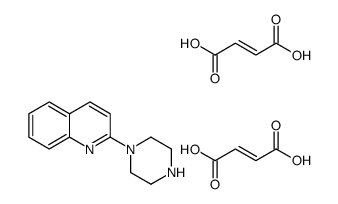Quipazine dimaleate
Modify Date: 2025-08-25 10:43:31

Quipazine dimaleate structure
|
Common Name | Quipazine dimaleate | ||
|---|---|---|---|---|
| CAS Number | 150323-78-7 | Molecular Weight | 445.42300 | |
| Density | N/A | Boiling Point | N/A | |
| Molecular Formula | C21H23N3O8 | Melting Point | N/A | |
| MSDS | N/A | Flash Point | N/A | |
Use of Quipazine dimaleateQuipazine dimaleate is a 5-HT agonist with a Ki value of 1.4 nM for displaces [3H]GR65630 from 5-HT3R in rat. Quipazine dimaleate shows antiviral activity against SARS-CoV-2 with an EC50 of 31.64 μM. Quipazine dimaleate behaves as a 5-HT3R antagonist in peripheral models. Quipazine dimaleate can be used for neurological disease research[1][2][3][4]. |
| Name | 2-(1-Piperazinyl)quinoline (2Z)-2-butenedioate (1:2) |
|---|---|
| Synonym | More Synonyms |
| Description | Quipazine dimaleate is a 5-HT agonist with a Ki value of 1.4 nM for displaces [3H]GR65630 from 5-HT3R in rat. Quipazine dimaleate shows antiviral activity against SARS-CoV-2 with an EC50 of 31.64 μM. Quipazine dimaleate behaves as a 5-HT3R antagonist in peripheral models. Quipazine dimaleate can be used for neurological disease research[1][2][3][4]. |
|---|---|
| Related Catalog | |
| In Vitro | Quipazine dimaleate 对 5-HT1 和 5-HT2 具有结合效能,Ki 值均为 230 nM[3]。 Quipazine dimaleate 取代大鼠内皮层中 5-HT3R 的 [3H]GR65630,Ki 值为 1.4 nM[3]。 Quipazine dimaleate 对大鼠迷走神经具有拮抗作用,对 5-HT2,5-HT1 以及抑制 5-HT 释放的 pIC50 值分别为 6.1,6.49 和 6.17[4]。 |
| In Vivo | Quipazine dimaleate (2.5,5 和 7.5 mg/kg,每个剂量各一次;腹腔注射) 影响雄性和雌性大鼠对不同宏量营养素饮食的膳食自我选择[1]。 Animal Model: Male and female Wistar rats feed with different sources of the three macronutrients (Group 1: casein, corn starch, safflower oil. Group 2: egg protein, corn starch/sucrose, lard. Group S: casein hydrolysate, maltose dextrin, butter.)[1] Dosage: 2.5, 5 and 7.5 mg/kg Administration: Intraperitoneal injection; 2.5, 5 and 7.5 mg/kg, one dose for once Result: Increased water intake and food intake of male rats from Group S, and reduced food intake of female rats from Group 1 and Group 2s at 2h post-injection. Reduced food intake in female rats from Group 2, reduced protein intake in female rats from Group 1. |
| References |
| Molecular Formula | C21H23N3O8 |
|---|---|
| Molecular Weight | 445.42300 |
| Exact Mass | 445.14900 |
| PSA | 177.36000 |
| LogP | 1.46180 |
| InChIKey | VAOSOCRJSSWBEQ-SPIKMXEPSA-N |
| SMILES | O=C(O)C=CC(=O)O.O=C(O)C=CC(=O)O.c1ccc2nc(N3CCNCC3)ccc2c1 |
| (+)-Anabasine hydrochloride |